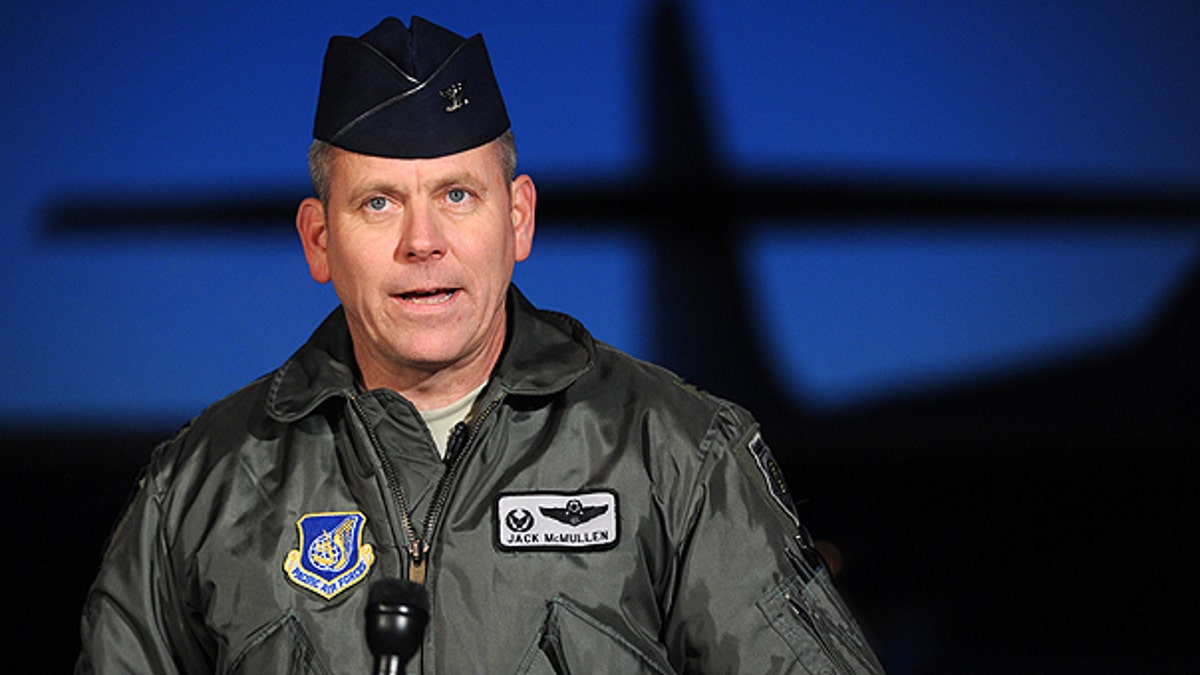
Nov. 19: Col. Jack McMullen, 3rd Wing commander, announces the death of pilot Capt. Jeff Haney based on evidence at the F-22 Raptor crash site. (AP)
ANCHORAGE, Alaska – Evidence found at the remote, rugged Alaska site where an F-22 Raptor crashed indicates the pilot died, an Air Force official said Friday evening.
Part of the fighter jet's ejection seat was found at the site, which means Capt. Jeffrey Haney of Clarklake, Mich., was not ejected and could not have survived the Tuesday night crash, Col. Jack McMullen said.
"If the pilot was able to eject, the seat would go with him," McMullen said. Also, an emergency locator transmitter would have been activated if the pilot had ejected and it was not.
Also found were pieces of the flight suit Haney had been wearing.
No body or remains have been found at the site, which McMullen described as a wet area. He said the impact of the crash caused a large crater that swallowed up much of the jet. Recovery efforts are expected to last several weeks, given the challenges of removing the wreckage. McMullen said the effort involves about 130 personnel in temperatures that plunge to 20 below at night.
"It's a very austere location and we're having to set up tents and food," he said.
Haney's single-seat jet crashed during a training run about 100 miles north of Anchorage near Denali National Park. He was assigned to the 525th Fighter Squadron, 3rd Wing, at Joint Base Elmendorf-Richardson.
"Obviously, this is a huge loss for the 3rd Wing and for the Air Force, but it's even a greater loss and it's a very emotional time for the entire Haney family," said McMullen, the 3rd Wing commander.
Searchers found the crash site Wednesday but had not previously been able to extensively inspect the hard-to-reach wreckage.
An investigation team will look at the cause of the unknown crash, which occurred in clear conditions.
"The weather was beautiful," McMullen said. "You could see the ground, you could see mountains, you could see the terrain."
Haney was married with two children. Officials said he joined the Air Force in 2003 and has been at the Anchorage base for 4 1/2 years.
The F-22 took off Tuesday from the joint Air Force and Army base for a training run.
The jet and a second F-22 practiced "intercepts" and were nearing completion of the exercise when one aircraft disappeared from ground radar tracking and from communications with the other F-22 at 7:40 p.m. Tuesday. McMullen said the plane's transponder was acting normally and stopped transponding when the jet crashed.
An air search had been ongoing, with searchers looking for any sign of a parachute or a fire the pilot might have started had he been able to eject from the plane.
Alaska has had multiple fatal plane crashes since early June, including an Aug. 9 crash that killed former U.S. Sen. Ted Stevens and four others.
In July, a C-17 cargo jet from the 3rd Wing crashed at Elmendorf during a training demonstration for an air show, killing all four crewmen aboard. Other crashes occurred at Denali National Park, central Alaska and in a busy business district near downtown Anchorage.

